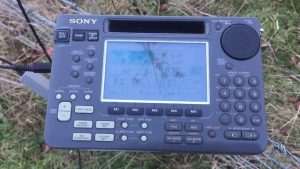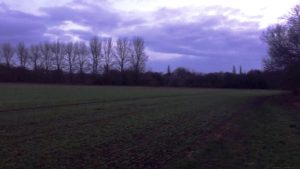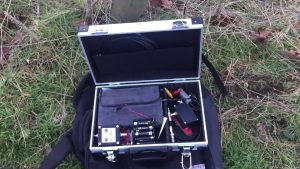Hi there, a few days ago I posted some reception videos comparing the performance of the Boni whip with a 30 metre longwire antenna at home, with a further check against the performance of the H field Wellbrook ALA1530 active loop. The conclusion of those tests was essentially confirmation that E field antennas don’t usually perform very well under a blanket of ‘electrosmog’ and that only on Longwave, did the Boni whip prevailed over the longwire; otherwise there was no usable difference in performance between the two.

 Sony ICF-SW55 receiver ‘Quiet’ location for Boni whip test
Sony ICF-SW55 receiver ‘Quiet’ location for Boni whip test
This prompted a number of my subscribers to ask when I would be taking the Boni whip on a DXpedition for an outdoor test against the Wellbrook and either a substantial longwire, or the 200 metre Beverage. Time is limited right now for a full test, however, I managed to throw together a kit of parts necessary to run a quick set of comparison tests with the whip, against the barbed wire fence I use for ad hoc DXing when out walking the dog! Over a period of an hour or so, I managed to copy a few stations on 31 and 49 metres and thus recorded signals using the Sony ICF-SW55 receiver with the Boni whip and barbed wire fence. Now previously, I have used that fence as an antenna for the excellent little Tecsun PL-310ET, with some nice results. However, after this series of tests, my views on the fence have changed a little. Obviously it might be somewhat directional and earthed along it’s length, neither of which I’ve checked, however, notwithstanding these performance-related factors, the performance of the whip which at home had been terrible, surprised me greatly. Text links to a set-up video and the reception videos on my Oxford Shortwave Log YouTube channel follow directly below, with embedded videos at the end of the post.
Finally, if you’re looking for a well performing, compact and portable active antenna for outdoor use in quiet environments and of course, DXpeditions, I would definitely recommend the Boni whip. Just bear in mind that the SNR it delivers at home might not be usable for anything more than casual listening.
Thanks for watching/listening/reading and I wish you all great DX!
- 240 metre barbed wire fence versus Boni whip: Zambia NBC Radio 1, 5915 kHz
- 240 metre barbed wire fence vs Boni whip: Voice of Africa 9505 kHz, Sudan
- 240 metre barbed wire fence versus Boni whip: AIR National Channel 9380 kHz
- 240 metre barbed wire fence versus Bonito Boni whip: Voice of Indonesia 9525 kHz
- Setting up to compare the Bonito Boni whip performance to a 240 metre barbed wire fence
Clint Gouveia is the author of this post and a regular contributor to the SWLing Post. Clint actively publishes videos of his shortwave radio excursions on his YouTube channel: Oxford Shortwave Log. Clint is based in Oxfordshire, England.



Height and grounding is very important of E-field antennas! My MiniWhip is mounted on our block (35m high) and the coax (RG58) is attached to the lightning rod 3 times! I live in a middle of big urban environment, and there is no chance to mount a big antenna on the roof, because a GSM provider already using it.
The most noisy part of the band now is around 300 kHz and 7500 kHz. Other parts of the band are surprisingly quiet.
The result can be viewed on my SDR: http://sarloutca.ddns.net:8073/
This is exactly what I have written about E field antennas all the time. My E field antenna is mounted away from my house as far as possible. The feed uses about 30 m of triple-shielded sat TV cable.
BTW: Height is important for E field antennas, too: The DL0IGI 10m beacon is some 50 km from here. moving my antenne up from 2m to 7m above ground resulted in about 10 dB more signal.